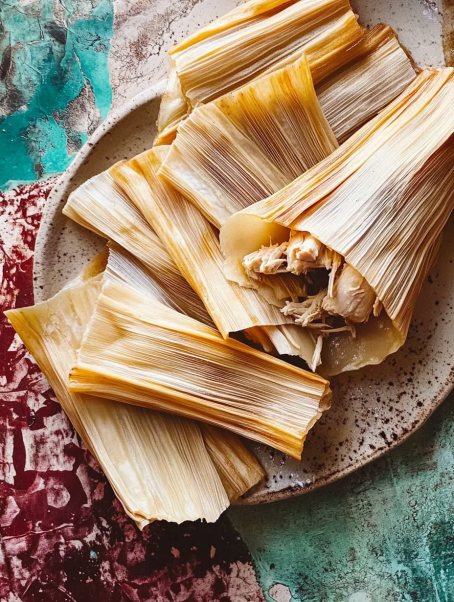Tamales de Pollo, or Chipotle Chicken Tamales, are a traditional Mexican dish with rich flavors. These tamales are filled with a savory tinga de pollo (chicken with chipotle and onions) and wrapped in corn masa dough. The masa is soft and flavorful, making these tamales a delightful meal. They require some preparation, but the process of making and steaming them is very rewarding. This recipe, shared by Alicia Villanueva from Alicia’s Tamales Los Mayas, is a great way to celebrate the flavors of Mexican cuisine.
Full Recipe:
Ingredients:
For the Tamales:
- 20 dried corn husks (from about 8 ounces)
- 3½ cups (410 grams) harina de maíz nixtamalizado (corn flour such as Maseca)
- 1 teaspoon fine salt
- ½ teaspoon baking powder
- 6 tablespoons lard or vegetable oil
- 2½ to 3 cups chicken broth or water
- 1½ cups Tinga de Pollo (Chipotle Chicken Filling)
For the Tinga de Pollo (Chicken Filling):
- Chicken (typically shredded with chipotle peppers and onions)
Directions:
- Prepare the Corn Husks:
- Place the dried corn husks in a large bowl, covering them with warm water. Weigh them down with a plate if needed, and let them soak for at least 1 hour, up to 3 hours.
- Prepare the Masa:
- In a large bowl, whisk together the harina de maíz nixtamalizado (corn flour), salt, and baking powder.
- Add the lard (or vegetable oil) and rub it into the dry ingredients with your fingers until the mixture feels sandy.
- Gradually add 2½ cups of chicken broth, ½ cup at a time, mixing and kneading the dough after each addition until fully incorporated. The dough should be soft and tacky, but not sticky. Add more broth if needed.
- Assemble the Tamales:
- Take a soaked corn husk and pat it dry. Spread a handful of masa (about ¼ cup) in the center of the husk, covering about two-thirds of the husk with a layer of masa that is about ¼ inch thick.
- Leave at least 3 inches clear at the pointed end and an inch on the sides.
- Add a heaping spoonful of tinga de pollo filling lengthwise down the center of the masa.
- Fold the right side of the husk over the filling, then roll tightly to the long end of the husk. Fold the pointed end of the husk over to close the tamale.
- Steam the Tamales:
- Prepare a large steamer by setting a rack or insert above gently boiling water.
- Stack the tamales flat, seam side down, leaving an empty space in the center. Cover them with remaining husks, then place a lid over the top.
- Steam the tamales for about 45-55 minutes, replenishing water as needed. They are done when the masa is firm and comes away easily from the husk.
- Serve:
- Once cooked, remove the tamales from the steamer and keep warm. Serve them as a delicious and comforting meal.
Nutritional Information (Approximate per tamale):
- Calories: 210
- Fat: 10g
- Carbohydrates: 24g
- Fiber: 3g
- Protein: 7g
This recipe yields 12-16 tamales, depending on the size of the husks and how much masa and filling you use. The tamales can be frozen for later use. To serve, simply thaw them overnight in the refrigerator and steam until heated through.
Enjoy your homemade tamales!
The History and Significance of Tamales
Tamales have a rich and long history that dates back thousands of years to the ancient civilizations of Mesoamerica, particularly the Aztecs and the Mayans. These cultures would prepare tamales as portable food for warriors, travelers, and priests. The concept of wrapping food in corn husks or banana leaves made them easy to transport, while the masa dough protected the fillings during cooking.
Throughout history, tamales have evolved into a popular dish for many different occasions, from family dinners to festive holidays such as Christmas and the Day of the Dead. Today, tamales are commonly served as street food, at parties, and during special events, and they come in a wide variety of fillings, including beef, pork, chicken, vegetables, and cheese.
Tamales de Tinga de Pollo is a more modern variation of the classic chicken tamale, filled with tinga – a dish made from shredded chicken, chipotle peppers, and a rich tomato-based sauce. This version reflects the blending of traditional flavors with regional influences, making it a perfect example of the versatility and innovation found within Mexican cuisine.
Ingredients: Masa, Tinga, and Corn Husks
At the heart of every tamale is the masa – a dough made from harina de maíz nixtamalizado (corn flour), which is mixed with a liquid (usually chicken broth or water) to form a smooth and pliable dough. The quality of the masa is crucial for making tamales that are tender and flavorful. For the best results, it’s essential to use the proper type of corn flour, such as Maseca, which is specially prepared for tamales.
Tinga de Pollo is the filling that makes these tamales unique. This shredded chicken filling is cooked with chipotle peppers, which add a smoky, spicy flavor, and onions, which provide sweetness and depth. The rich combination of tomatoes, garlic, and other seasonings results in a filling that’s savory, smoky, and slightly spicy – a perfect complement to the mild flavor of the masa.
Another key ingredient in making tamales is the corn husks. These dried husks are soaked in warm water to soften them before being used to wrap the masa and filling. The corn husks not only serve as the perfect wrapping for tamales but also impart a subtle corn flavor and aroma to the dish as they steam.
The Art of Making Tamales
Making tamales is often considered an art form in Mexican cuisine. While the process can be time-consuming, the effort is well worth it for the result – tamales that are rich in flavor, tender in texture, and packed with history.
To start, the corn husks must be soaked in warm water for at least an hour, which softens them and makes them more pliable. This step is essential to ensure the husks don’t tear when wrapping the tamales.
The masa is then prepared by mixing the harina de maíz nixtamalizado with salt, baking powder, and either lard or vegetable oil. The dough is kneaded and gradually mixed with chicken broth until it reaches the right consistency – soft but not too sticky. The perfect masa is a crucial component for making tamales that are both flavorful and tender.
Once the masa is ready, the tamales are assembled by spreading a layer of dough on the corn husk and adding a spoonful of Tinga de Pollo filling. The husk is folded over the filling and rolled tightly to seal it. The folded end is tucked under to prevent the tamale from unrolling during steaming.
Tamales are traditionally steamed in a large steamer, where they are placed flat, seam side down, and covered with additional corn husks to trap the steam. They are steamed for about 45-55 minutes, until the masa is firm and pulls away easily from the husk. The steaming process ensures that the tamales are cooked thoroughly, resulting in a soft, flavorful treat.
Serving Tamales de Tinga de Pollo
Tamales are best served hot, fresh from the steamer, and are typically enjoyed as a main dish or snack. Tamales de Tinga de Pollo are versatile and can be paired with various sides to create a complete meal. A simple accompaniment such as Mexican rice, refried beans, or a fresh salad can balance the richness of the tamales.
In Mexico, tamales are often served with salsa verde or salsa roja, which adds a fresh, tangy contrast to the savory tamales. A dollop of sour cream or a squeeze of lime also enhances the flavors, making for a delightful combination of tastes.
For a more festive experience, tamales can be served at gatherings or family celebrations, where they can be enjoyed alongside other traditional Mexican dishes like pozole, enchiladas, or chile rellenos. Serving tamales in this context not only celebrates Mexican cuisine but also brings people together to share in the joy of food and tradition.
Cultural Significance and Modern Variations
In addition to their historical importance, tamales hold significant cultural value in Mexican society. Making tamales is often a communal activity, with families and friends gathering together to prepare the ingredients, assemble the tamales, and share in the cooking process. This tradition is especially prominent during the holiday season and special events such as Las Posadas (the Christmas festival) and Día de los Muertos (Day of the Dead), where tamales are a symbol of warmth, togetherness, and celebration.
While the traditional filling for tamales is often made with pork or beef, modern variations have introduced an array of new ingredients, such as vegetarian tamales, sweet tamales, and even tamales with different meats like chicken, turkey, or lamb. Tamales de Tinga de Pollo represents a fusion of flavors, combining the spiciness and smokiness of chipotle with the comfort of traditional chicken filling, offering a new twist on an age-old favorite.
In the U.S., tamales have become a popular dish in Mexican-American communities, especially during Christmas and New Year celebrations. Many Mexican-Americans have embraced making tamales at home as a way to connect with their cultural roots and share this beloved dish with the next generation.
Tamales: A Dish for All Seasons
While tamales are often seen as a holiday dish, they are perfect for any time of year. The process of making tamales can take some time, but the result is always worth the effort. These tamales make excellent party food, comfort food, or a fun weekend cooking project. Whether served for a casual dinner or as part of a festive celebration, tamales bring people together to enjoy good food, good company, and time-honored traditions.
Conclusion: Why You Should Make Tamales de Tinga de Pollo
Making Tamales de Tinga de Pollo at home is a rewarding experience that brings the flavors of Mexico to your kitchen. With their rich, smoky filling and soft masa dough, these tamales are a perfect representation of the depth and diversity of Mexican cuisine. Whether you’re cooking for a family meal or a special celebration, tamales are a dish that brings warmth, flavor, and tradition to the table.
By taking the time to prepare the masa, filling, and steaming process, you create not only a delicious dish but also an opportunity to connect with the cultural heritage of Mexico. So, gather your ingredients, invite your friends or family, and enjoy the process of making these flavorful Tamales de Tinga de Pollo – a true Mexican culinary experience that will be enjoyed by all.






